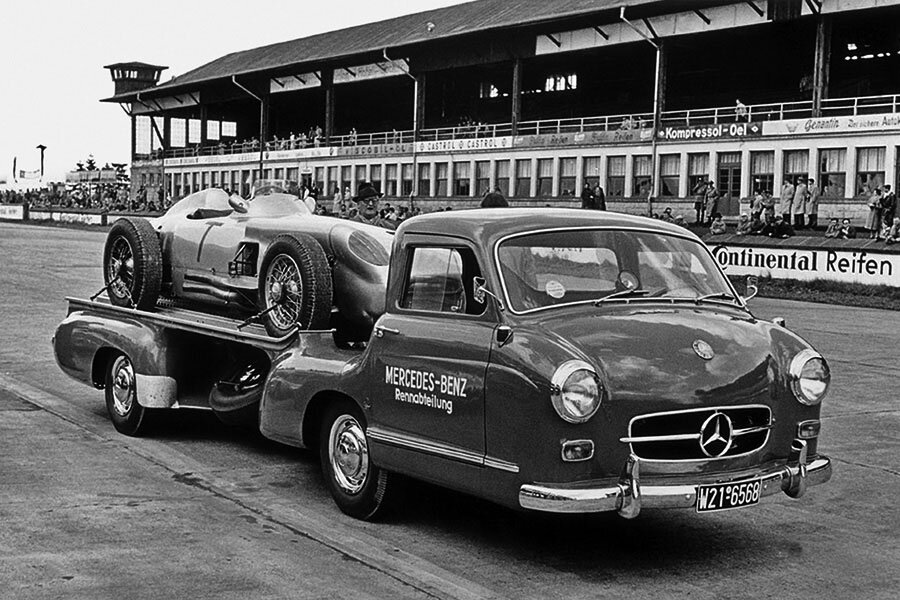Guide: Mercedes-Benz Blue Wonder - a Historical & Technical Appraisal
/BACKGROUND
In 1955, Mercedes-Benz unveiled a high-speed racing car transporter, the like of which had never been seen before.
Nicknamed Blue Wonder, it was built at the request of Mercedes’ racing team manager, Alfred Neubauer. The design was undertaken by chief engineer, Rudi Uhlenhaut.
Commissioned in 1954, Blue Wonder went into service for the 1955 season. It often received as much attention as the racing cars themselves.
That year, Mercedes were competing on two fronts.
They contested the Formula 1 World Championship with the W196 and the World Sportscar Championship with the W196S 300 SLR.
With the majority of races held in Europe, Blue Wonder was deployed whenever a car needed to be moved quickly from the factory to the circuit or vice versa.
Mercedes had a history of fine transporters. Between 1920 and 1934, they had built a series of custom-bodied creations, but nothing as spectacular as Blue Wonder.
This latest one-off truck used a mixture of brand new components along with parts derived from the 180, 300 S and 300 SL.
CHASSIS
The tubular steel X-frame chassis was a lengthened version of the type used on the W188 300 S. It had a wheelbase extended from 2900mm to 3050mm and was suitably reinforced.
Front suspension was independent via coil springs and wishbones while the back end featured a swing axle.
Wheels measured 15 x 5.5-inches, drum brakes were fitted all round and the steering was controlled by an extended multi-segment rack that travelled back underneath the cockpit.
ENGINE / TRANSMISSION
Like the front wheels, the engine was also mounted behind the cab.
A three-litre straight six with a cast-iron block and aluminium-alloy head, it was sourced from the recently introduced W198 300 SL Gullwing. This in turn was a big valve version of the motor used in the W194 SL racing cars of 1952.
It featured a single overhead camshaft with a forged steel crankshaft, dry-sump lubrication and Bosch fuel-injection.
Displacement was 2996cc and compression would have been around 8.0:1 for an output of circa 220bhp at 5800rpm.
Transmission was via a four-speed manual gearbox.
BODYWORK
To complement its unusual mechanical specification, Blue Wonder was given an equally distinctive appearance.
The cab had an extreme forward control position. Styling cues were from the Gullwing and W120 Ponton.
A fully clad rear gave the look of a one-piece body with the separation between cab and bed barely visible.
At seven metres long and two metres wide, Blue Wonder was much smaller than most trucks. This enabled it to travel along minor roads and those with low bridges normally inaccessible to car transporters.
The finished truck was painted in Mercedes-Benz Royal Blue.
INTERIOR
The cockpit was strictly for two occupants.
Bucket seats were upholstered with dark blue bolsters and tartan centres. The door panels were trimmed to match.
One interesting feature was an early attempt at cruise control; a stick to the driver’s right-hand side could be deployed to keep the throttle held flat to the floor!
A 7000rpm rev counter was located on the steering column with a speedometer directly behind on the dash. Supplementary gauges were positioned either side of the speedometer.
The dash was upholstered in dark blue leather. Matching dark blue carpet covered the floor.
WEIGHT / PERFORMANCE
Weight was an estimated 2.5 to 3 tons.
Depending on the payload, top speed was between 160kmh and 170kmh which made Blue Wonder easily the world’s fastest transporter.
For comparison, at the time, most other trucks struggled to exceed 70kmh.
SERVICE LIFE
Mercedes used Blue Wonder throughout their successful 1955 season.
That year, Juan Manuel Fangio and Stirling Moss took first and second in the Formula 1 Driver’s Championship.
Had there been a Constructor’s title (not introduced until 1958), Mercedes would have easily won that too.
In the World Sportscar Championship, Mercedes pipped Ferrari to the title, but the season was overshadowed by the infamous disaster at Le Mans when Pierre Levegh’s works 300 SLR was launched into the crowd at 125mph. The French driver was killed instantly and 83 spectators lost their lives.
In light of this, Mercedes-Benz withdrew from motor racing at the end of 1955.
SUBSEQUENT HISTORY
Blue Wonder briefly served as an exhibition vehicle in the USA before returning to Germany.
For a while, it was used by the test department until being parked outside where it was slowly left to rot.
In 1967, Rudi Uhlenhaut made the decision to scrap it.
Later realising this had been a mistake, Mercedes set about recreating Blue Wonder in 1993.
No drawings, blueprints or technical records existed as the original had been an unofficial project created by Uhlenhaut in the back of the racing department.
6000 hours were spent on building an exact reproduction albeit with a more practical 192bhp engine.
The completed machine was unveiled at the Goodwood Festival of Speed in 2001.
Text copyright: Supercar Nostalgia
Photo copyright: Mercedes-Benz - https://www.mercedes-benz.com


































